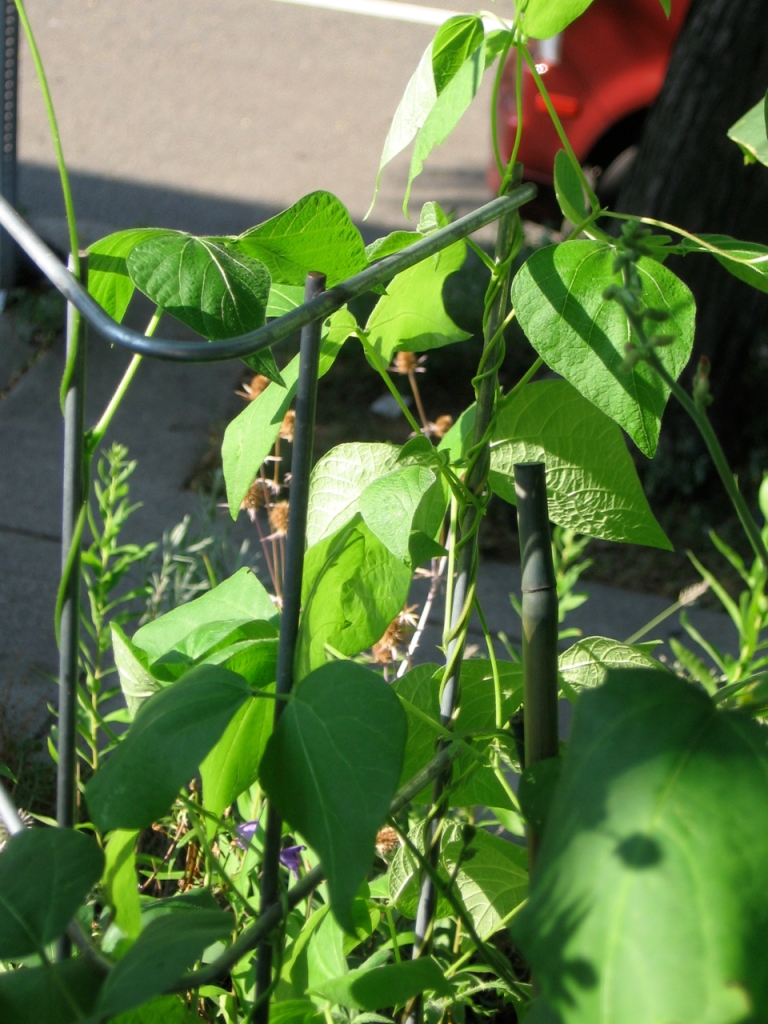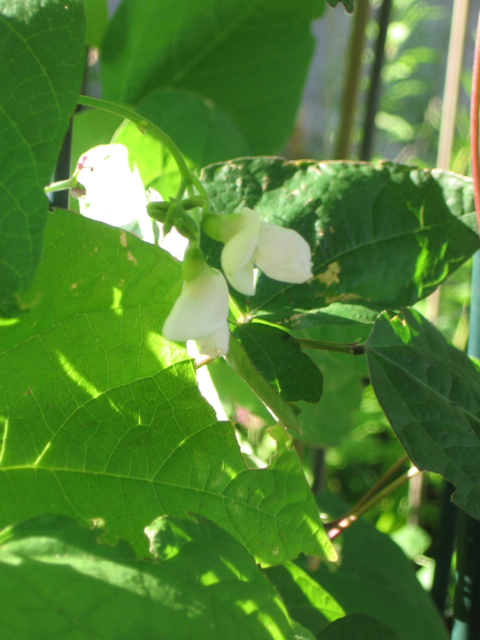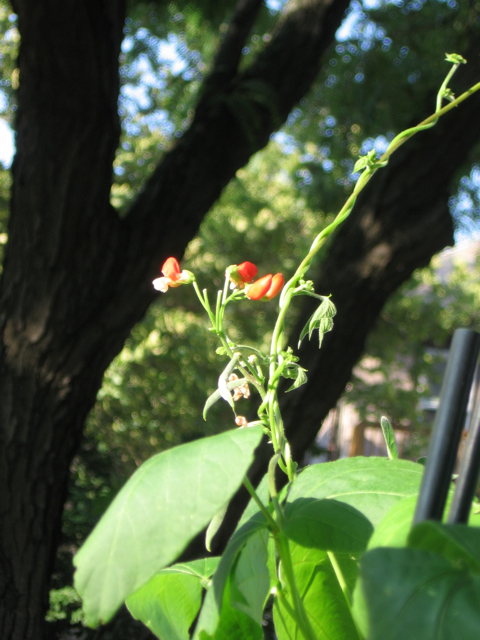So typical of gardeners, today I went to the nursery, ideas in my mind of new plants to add to the improvements I just made with yesterday’s plantings, and curious as to what was there in the week since I’d last stopped in (and just looked, not bought) – and of course ended up finding new plants to bring back with me. The front border is so full now that there’s not really much room left for large-pot plants, just on the back and one side (the other two edges are the hard edges of the retaining wall). I’ve got an idea in my head to make a second, much smaller border against the house perhaps with hostas and astilbles (that area is both shady and hot, a difficult combination, though I’m not sure if it’s as windy as the rest of the garden), but that’s just a fragment in my head so far. It would be bordered with rocks dug up from the garden like the current front bed and I generally think it would make a nice complement, and better unify the garden and the house, but it would mean almost all the grass in front would be gone then and I don’t know whether my landlord would really like that, and it would also leave a narrower path to the back yard, increasing the likelihood that people other than me would unintentionally damage plants near the path.
Anyhow, my original point was that the size limits matter more at this time of year because there are so many fewer plants in smaller pots at the nursery. I ended up getting some more annuals (a number of the ever-shrinking tiny section of small-potted annuals; almost all the remaining annuals at the nursery are in big clumps in big pots) and two more herbs, a third catnip – this one just the straight species rather than the two ornmanetal cultivars I’d already planted, one last year and one this year – and oregano ‘Hopley’s Purple’. Both of the herbs were in full bloom and the catnip was being wildly attacked by hungry pollinators, whereas the ‘Hopley’s Purple’ was just so pretty to me (looking at my garden, anyone can easily see my weakness for flowers in purpley hues). Don’t listen to sources that say ‘Hopley’s Purple’ is hardy to my USDA zone or above; I’ve read from reliable sources that it’s only hardy to around USDA zone 7, dying if temperatures dip near zero. Despite this fact, it blooms from early or mid-summer into the autumn, huge clusters of beautiful tiny purple flowers on deeper purple stems, with tiny leaves brushed with purple until they age, and it’s a lovely addition to a decorative herb garden. This brings my oregano total to six: hardy marjoram (really an oregano), Greek oregano, sweet marjoram (a tender herb in the oregano genus), ‘Hopley’s Purple’, and the two ornamental oreganos I planted yesterday, ‘Amethyst Falls’ and cascading oregano. (Despite being called Cuban oregano, my Cuban oregano is neither an oregano nor originally from Cuba.)
The largest potted thing I got was an agapanthus, which according to the tag blooms longer than other agapanthus. It’s got beautiful white clusters of bloom (I believe it is ‘White Ice’). Though it’s quite pretty, the reason I really got it was because it was wildly popular with pollinators, the most popular thing in an entire aisle of annuals. It was so popular as I set it down upon reaching home, a flower fly was already hovering, waiting for it to stabilize so the flower fly could start eating. I’ve never grown them before (they aren’t hardy here) and after reading about their super thick root system at this page I am thinking it might be good to place in in the sparse, especially windy, especially erosion proof section at the edge of the front garden. Hopefully the page is right about how even gales can’t topple their bloom stalks, because that section of the garden sure does get some gales.
One of the pea plants has died and a second one is dying. It looks like the fava/broad beans might have dropped some of their beans but there are some that are getting close to picking size (finally). In what seems like overnight, the filet beans have gone from half-inch baby beans to near picking size. I planted a Renee’s Garden Seeds mix I bought last year but didn’t grow, the ‘French Duet’ mix, which consists of yellow filet bean ‘Ramdor’ and green filet bean ‘Emerite’, which Renee’s says they get from a French seed house. I’ve not grown them before and so far ‘Emerite’ has been doing very well; it’s got a lot of developing beans on it. If ‘Ramdor’ has any, I haven’t seen them yet, but the bean plot is kind of, well, messy. Between the garden beans, lima beans, akira beans (though they prefer cooler weather and I planted them late enough that I suspect they will die before producing) runner beans, garden peas, sweet peas (planted at the edge of the patch), hyacinth beans, and extra stakes to help keep the fava/broad beans and soybeans from toppling in the wind – there are easily thirty-five stakes in the patch!
Speaking of the sweet peas, I eat my words: A second bloom appeared today, the rich pink of a summer sunset, edged with pure white. The pewter blue bloom from yesterday is still there, and it’s visually the same height and about an inch over, so they look pretty interesting together. It looks like each plant has one or two more buds already formed, but I don’t see buds on any other pea plants, be they sweet or garden. Whether it’s dry or muggy, most days now it’s at least eighty, sometimes feeling like it’s about a hundred, and that’s just too hot for peas to generally really do very much. (And the front garden always, always feels hotter than the back, since it’s got a concrete retaining wall and is by a sidewalk and a road.) I’m growing scarlet runner bean again, but this time I’m growing a different cultivar, ‘Dwarf Bees’, and it’s been blooming every day now for several days. Hopefully it will keep up till frost as supposedly happens with this cultivar. I’m pleased with this one; last year it took the other cultivar significantly longer to flower, though in fairness, I hadn’t added as much compost to the bean patch and there weren’t as many other robust plants in the bed to help break the wind and cool off the roots.
The first two hollyhock blooms finally opened overnight after weeks of buds. They’re on one of the fig-leaf hollyhocks (which are supposed to be much more rust-resistant than the standard hollyhocks). They are a rich magenta, deeper of hue at the center than edges, and are ruffled around the edges. I never knew you could eat mallow family flowers and leaves (though presumably not EVERY mallow family member) until I met someone who’d lived in Cyprus for several years and said young mallow leaves are eaten as a vegetable there and the flowers are sometimes used for, say, holding dips at parties. I’ve noticed that a lot of plants adapt to life in a windy site. My perennial garden phlox, for example, are shorter than most of the other gardens’ phlox around here. So far this is true of the hollyhocks as well (although they were planted last year, this is their first year blooming/budding); they often reached six feet in my old garden, and so far in this one the tallest is only about three feet tall.




Recent Comments